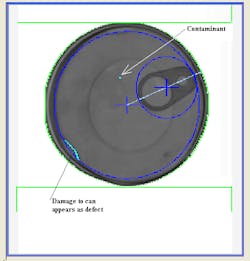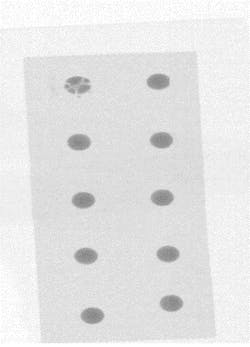Is it time to take a fresh look at X-ray inspection technology?

X-ray inspection technology is a familiar feature on factory production lines. But what is not so familiar is the vast variety of things the latest generation of X-ray inspection technology can detect — it now can do so much more than find a fragment of metal or glass in a box of chicken nuggets.
Has a product got the correct amount of filling, for example — and is it evenly distributed within the product? Are there any missing or damaged items in a multipack? Is there a speck of sauce trapped in the seal of a ready meal — letting in oxygen to spoil the food? Are there any air bubbles in a vial of liquid medicine? Are there any missing or damaged pills in a blister pack?
The questions are almost endless. But the answers are increasingly being provided by X-ray inspection technology, which has come a long way since it was first used on the production line to detect stray fragments of metal 35 years ago.
The technology can be used to check the weight of a product, for example — and also the individual weights of a series of items within a pack. So, it can check that a box of chocolates has the right chocolates in the correct positions — and that each donut is filled with the correct amount of jelly. It can also detect and reject a fruit pie with less filling than the others in a multipack, even if some of the others have slightly too much filling.
The inspection settings can also be optimized for the different zones within packaging. A chocolate chip cookie, for example, contains relatively dense pieces of chocolate — so the contaminant parameters for that section of a biscuit box insert will need to be detuned. The zone containing rich tea biscuits, however, has no such requirement — so maximum sensitivity can be maintained.
Yogurt products with a serving of fruit in the corner are another optimization example. The fruit represents a relatively low part of the product's weight. However, the latest generation of X-ray technology can accurately measure this, regardless of the amount of material in the yogurt zone. It can even measure additions such as crispy rice cereal, where the nominal weight of the mixing material is even less.
The latest generation of X-ray inspection technology can even tell when cheese is at its best and therefore ready for eating. In the course of maturing, certain types of cheese — such as Emmental and Leerdammer — will produce holes or "eyes". The sizes and densities of these holes are a measure of the quality of the cheese. Traditionally, this has been checked by core sampling — but that is a destructive and manual process. X-ray inspection, on the other hand, can quickly provide a tomographic analysis of the entire cheese and, if the hole density is found to be too low, the cheese can be retained for longer maturation. The technology can even give an indication of when the cheese is likely to be ready for cutting — maximizing the value of the product.
Seal inspection is another aspect of food processing benefiting from the latest generation of X-ray inspection technology. Once the protective gas mix has reduced the amount of oxygen inside the food packaging, a good seal is crucial to help the contents stay fresh for as long as possible. If a small drop of sauce gets caught up in the seal of a ready meal's packaging, for example, it will break the airtight seal and allow in oxygen — which will make the product spoil faster and lead to wastage and customer complaints. With the latest X-ray technology, two images are generated from a single detector — one optimized for the product and one for the seal area. It means even the tiniest breach of the seal can be detected.
For protein products packaged with a deoxidizer or oxygen scavenger — typically a small pouch or sachet of ferrous oxide to remove any last traces of oxygen from inside packaging — X-ray inspection technology can confirm the presence of a single deoxidizer in each pack. And the latest developments in image processing software now enable the pouch or sachet to be masked out from the inspection of the rest of the product.
Many other features that would otherwise be seen as contaminants can also now be routinely masked out. The pull tab of a metal can, for example, could cause a false reject as it deviates from the uniform thickness of the main body of the can. But detailed information about the geometry of the can means the pull tab can be automatically located and defined as an area of lower sensitivity — giving a reliable means of inspection.
Image processing software now also provides the tolerance levels required to deal with the variable shape and thickness of glass containers. The technology can cope with the thick glass often found at the base of glass jars, along with tapered shapes, ridges and bulges.
The presence of bubbles in a fluid within a container can also be detected. The bubbles might be unwanted — if they affect the quality of the product or if the packaging has an aerosol attachment. Or the bubbles might be required — in aerated chocolate bars, for example. In each case, product quality can be confirmed.
Bubble detection also has a vital role to play in the pharmaceutical industry — ensuring there are no air bubbles in a vial of liquid medicine, for example. Of course, foreign body detection is also crucial for formulations in drug containers. X-ray inspection equipment can detect metal or glass particles as small as 0.1mm in diameter that would not be visible to the naked eye on a high-speed production line. The technology can also perform quality checks on drug delivery devices such as autoinjectors — ensuring the needles are in the correct position and that other parts of the device mechanism are within position tolerances.
Checking there are no extra, missing or incorrect tablets in a sealed blister pack on a high-speed factory production line is easier said than done. The latest X-ray systems combine low-energy X-ray imaging with active pixel sensor technology to achieve high sensitivity — with resolutions 10 times greater than traditional end-of-line X-ray machines. That means they can detect not only missing or broken tablets — with an inspection zone created around each tablet pocket — but also contaminants such as metal, even though the products are packaged in metallic blister packs. The technology can even detect paper inside cardboard — using adaptive algorithms to check that each box contains an "instructions for use" leaflet to ensure regulatory compliance.
Billions of people around the world rely on factory production lines for everything from their next snack to life-saving medication. Now the process industry can rely on a new generation of X-ray inspection technology for peace of mind that also helps maximize product quality, output and profitability.
Dr Richard Parmee is founder and CEO of X-ray inspection technology specialist Sapphire Inspection Systems. As well as designing bespoke solutions, Richard and his team provide a wide range of standard X-ray inspection systems to cater for hundreds of different products in the food, pharmaceutical and cosmetics industries.
About the Author
Richard Parmee
Founder and CEO of X-ray inspection technology specialist Sapphire Inspection Systems
Dr. Richard Parmee is founder and CEO of X-ray inspection technology specialist Sapphire Inspection Systems. As well as designing bespoke solutions, Richard and his team provide a wide range of standard X-ray inspection systems to cater for hundreds of different products in the food, pharmaceutical and cosmetics industries.

